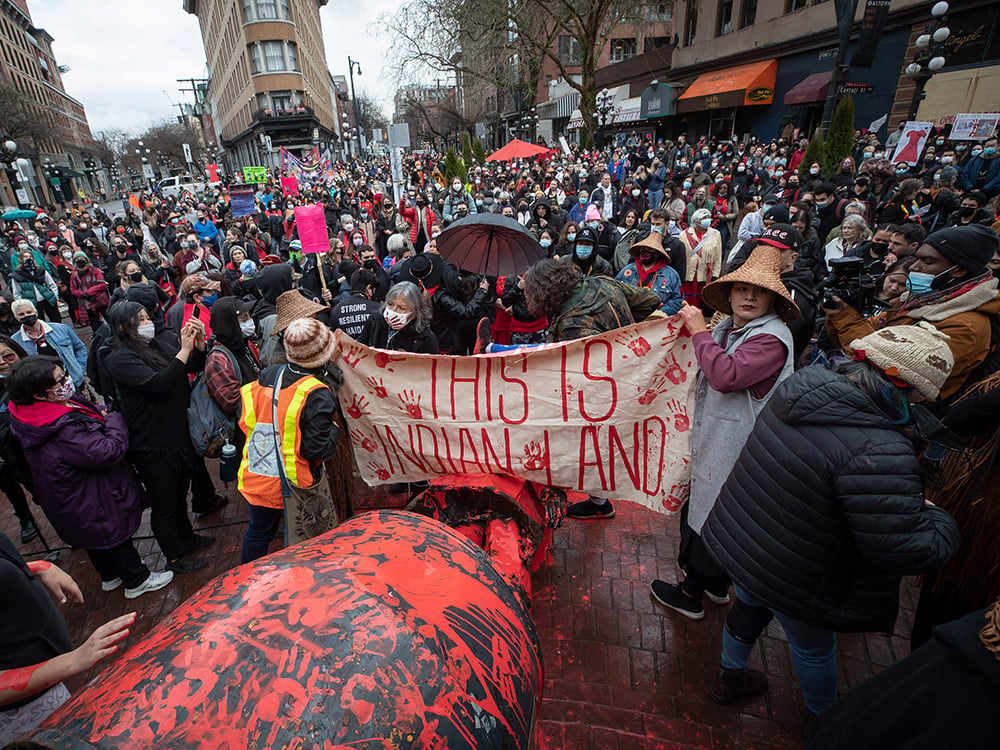When young Indigenous protesters toppled the statue of “Gassy Jack” Deighton on Feb. 14, the crowd cheered and sang as it crashed to the ground. Almost instantly, photos and videos of the moment began to circulate, garnering a wide-ranging set of critical and predictable responses.
Some, like Vancouver Coun. Sarah Kirby-Yung, called the action a threat to democracy. Others lamented the supposed destruction of history, calling for the statue to be preserved and used as educational content, or relocated to a museum. Many called for criminal charges to be laid. The phrase “cancel culture” made frequent appearances.
In recent years, a number of protests have culminated in the destruction of monuments to colonial figures. In Montreal, John A. Macdonald was beheaded; so was Egerton Ryerson in Toronto. In Victoria, Capt. James Cook was thrown in the harbour.
Deighton is less well-known beyond Vancouver: he is the namesake of Gastown, and he is also remembered for his marriage to a 12-year-old Skwxwú7mesh girl named X̱áliya. In recent years, many have objected to having a statue of a child abuser on display, one that failed to mention X̱áliya at all.
Each incident of destruction evokes the same reactions. There are those who agree that these monuments should be removed, but only through proper legal methods. It’s generous to assume patience will be rewarded by action. We live in a country where only 11 of the 94 Calls to Action from the Truth and Reconciliation Commission have been completed in the past six years. Removing statues would seem to be the easy work of reconciliation— unlike the Indian Act or systemic racism, a statue can be dismantled in an afternoon. And yet, tributes to the architects of genocide remain in cities across Canada.
There are also those who say that removing a statue by illegal means is undemocratic. But underneath that sentiment is the presumption that the statue’s installation was a democratic decision, as if Indigenous people agreed in the first place to honour their oppressors.
Others object to the removal by any means. They conflate statues with history, and history with intrinsic social value. The thinking goes that yes, the statues might honour people who did some bad things, but we need them to learn. Destroying them is like destroying history itself.
This is a curious argument. Nevermind that statues are not a primary method of recording or learning history; we have Wikipedia for that. Statues are not history at all, they are fiction: stories stripped down to fit on a plaque and sanitized for public enjoyment, in service of Canada’s image of itself as a great nation. And yet these facile stories are convincing and self-justifying. Many seem to believe that if someone was immortalized, they must have done something great to deserve it.
Someone great
This fallacy is exemplified by Gassy Jack. The statue was installed in 1970 by four real estate developers who were transforming the neighbourhood for profit, and saw in Deighton a convenient mascot who would evoke a sepia-tinged fantasy of the rollicking Wild West, designed to appeal to prospective condo dwellers. Larry Killam, one of the four businessmen behind the the Gassy Jack statue, was profiled by a 1971 issue of Maclean’s, which detailed his enterprising practice of purchasing “evil-smelling flophouses'' and “kick[ing] out the derelicts,” before renovating them to the tastes of young urban professionals.
Of Killam’s intentions, Maclean’s noted, “There was no romance in his thinking. He was out to make money.” Gassy Jack was a marketing stunt, and as such it has about as much historic value as a 52-year-old billboard. And yet the mere fact of its existence convinced many people it has public value. This conviction is reinforced by the money and effort the city has spent restoring the statue, which has been vandalized repeatedly in recent years, even as they were promising to eventually remove it.
These defenders like the story of Gassy Jack better than the ugly facts of Deighton’s life. They choose not to see what Indigenous people have always seen: an abuser, celebrated and exalted, his crimes forgotten, casting his shadow over a neighbourhood where countless Indigenous girls and women have been abducted, abused and killed. Preserving the story leaves no room for the truth.
“I grew up as an Indigenous woman watching women and girls disappear, and watching nothing done about it,” said T’uy’t’tanat-Cease Wyss, an artist and Skwxwú7mesh cultural leader who saw the statue come down on Feb. 14. “And I grew up in this city where the names of colonizers are on buildings, on streets. They are hailed and lifted up.”
A lack of engagement
Consultation is a kind of purgatory for reconciliation. Elected leaders are always in consultation, which is another way of saying they haven’t taken action yet. Since 2020, the City of Vancouver and Squamish Nation have been in discussion over the future of Gassy Jack. On Feb. 14, both released statements reiterating that they had been planning for its removal, though no timelines or details were provided. The statements have been amplified by many, who have condemned the statue’s removal as not just illegal but harmful to the goals of reconciliation.
“There have been so many conversations about it, but neither the city nor the nation made any announcements,” said Wyss. “They let it get to this point. They have to assume responsibility. When I look at what happened [to Gassy Jack], that’s the result when you don’t engage this community.”
The lack of information is striking, particularly in a city where a giant billboard goes up every time someone applies to redevelop a property. “When I see [the city] can put a sign up for a barge in a week, you can’t tell me that they couldn’t put a sign around the Gassy Jack monument to say, 'This is a conversation that’s happening,'” said Wyss. “There’s no excuse for that not to have happened in the first place. If people want to be heard, they have to speak.”
‘We want to take our power back’
Sii-am Hamilton, a Sto:lo and Nuučaan̓uł land defender who has ties to the Burrard and Musqueam Indian bands, was part of a group of Indigenous youth who led the removal of Gassy Jack under the guidance of community members. Hamilton says the action was undertaken with a full understanding of the possible consequences, by youth with ties to the host nations.
Hamilton and her fellow activists were frustrated by the talks between the Squamish Nation and the city and disagreed with the lengthy, bureaucratic process. “Indigenous youth engage in direct action,” she said. “It’s exhausting to be told to sit in a seat, to be told we’re in consultation, that there’s a process. We want to take our power back, in front of settlers who don’t recognize our power.”
Hamilton also disagreed that the future of the monument should be determined solely by the Squamish Nation. “I’m Coast Salish, I want to always recognize our communities. We have a historic presence on this land,” she said. But in her view, that’s a complex and nuanced relationship; it’s not as simple as deferring to the authority of a band council.
Hamilton believes these conversations and decisions need to include all the Indigenous people who are affected. “It’s not just us who lives here anymore, but we have guests and family who live on this land, and they also get a say. They also have a voice. That’s how you build wealth in our communities, by recognizing other people’s humanity.”
She explains, “St. Mary’s Residential School, which was one of the biggest schools and one of the last to close, is in Sto:lo territory. My mom attended; one of my closest friends, her dad attended. But it wasn’t just Sto:lo people who were affected— children from many nations also attended. And we need to give agency back to everyone who was harmed.”
When asked what she hopes will happen now that Gassy Jack is gone, Hamilton answers, “I hope people recognize why statues are erected, and why they’re taken down. People don’t have to agree with the process, but they have to reckon with the history.”
She adds, “And to the people who are really angry, who are feeling really averse to why a statue removal happened— I didn’t do it for them.”
Whatever one believes about the Gassy Jack statue, it’s gone. The story it has been telling for 52 years is over. There’s an opportunity now to look beyond the myth of Gastown and see the land beneath it, the history beyond it, and all the potential of the future generations who will pass through that neighbourhood unshadowed by Deighton’s looming figure. In its absence, we can imagine the different stories that we might tell instead. ![]()
Read more: Indigenous, Rights + Justice

















Tyee Commenting Guidelines
Comments that violate guidelines risk being deleted, and violations may result in a temporary or permanent user ban. Maintain the spirit of good conversation to stay in the discussion.
*Please note The Tyee is not a forum for spreading misinformation about COVID-19, denying its existence or minimizing its risk to public health.
Do:
Do not: